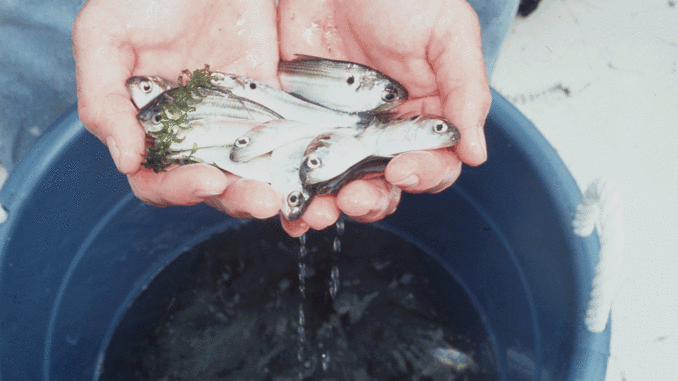
This Shearon Harris guide goes against the grain and targets deep bass with live shad.
Guide Greg Griffin of Holly Sprints is a live-bait specialist who dangles natural baits in front of fish instead of artificial replicas.
Griffin’s approach, mainly on display at Shearon Harris Lake, isn’t unique, in that many fishermen use live bait to catch fish: crappie, walleye, stripers, mountain trout, catfish or bream, not to mention saltwater species.
What sets Griffin apart is that he uses live bait to catch largemouth bass, a tactic that irks many other fishermen just as the use of live bait agitates many trout-fishing purists.
Some fishermen would rather torch their bass boast before dunking minnows in a lake or river for largemouth bass, believing that fishing with live bait isn’t as sporting or challenging as using artificials, relegating those who do as “meat fishermen.”
But Griffin grew up in Florida, where few anglers turn up their noses at users of live bait, especially the live shiners that have become famous for tempting big bass at places like Lake Okeechobee.
He knew all about catching largemouth bass on golden shiners when he moved to North Carolina, then caught stripers in the Roanoke River near Weldon on live bait, a tactic that worked wonders. When he began fishing Shearon Harris in 1991, he dropped minnows into its bass-rich waters with phenomenal success, which led him to open a guide business.
“I thought long and hard about it,” said Griffin (919-434-4183). “I wanted to incorporate live-bait fishing with guiding because it was something different, and no one else was doing anything like it for largemouth bass.”
Griffin guides from late May through early November, the same time frame favored by many structure-oriented crankbait fishermen. He said his live-bait approach is similar to structure fishing with crankbaits or Carolina-rigged plastics. He said the ability to locate bass and forage around structure with a depthfinder is just as essential when using live bait as it is for deep-water cranking.
“The fish are so deep, they’re not bothered as much with changes in pressure or weather fronts, so they remain in large schools,” he said.
Griffin uses freshly caught 3- to 6-inch shad that he catches in a cast net; he prefers the larger sizes. He fishes them on a Carolina rig with a 1-ounce egg weight — 2- or 3-ounce sinkers on windy days — a protective bead and a 16- to 18-inch fluorocarbon leader and a 3/0 or 4/0 Gamakatsu finesse wide-gap hook.
“These hooks act like circle hooks because they’re less likely to damage fish,” he said. “The main difference is that you get to set the hook. With circle hooks, you wind in to set the hook.”
Griffin hooks the shad behind the dorsal fish if he’s making short casts. For longer casts, he hooks the shad through the gristle at the nostril. He replaces baits after each cast.
“I never cast the same bait twice,” he said. “The shad must be fresh, not pale. When I’m free-lining, I might use the same bait for a few casts, but otherwise, I change the bait with each cast.”
Griffin anchors while fishing and positions his boat so he can lob his bait directly into the fish he’s found on his depthfinder. He doesn’t get too close, fearing that dropping the anchor might spook the fish. He favors tapering points that drop into 30 feet of water.
“I don’t fish ledges or steep banks,” Griffin said. “They don’t hold large schools of bass like long, tapering points where good numbers of fish can spread out.”
Griffin fishes from a Carolina Skiff and usually sets out one rod per fishermen to avoid tangles. He doesn’t use rod holders, encouraging his clients to hold their rods so they can feel the bites and make quicker hooksets.
“There’s less of a chance of gut-hooking a fish if a client holds the rod instead of placing it in a rod holder,” he said. “Dead fish don’t do us any good.”
If Griffin finds bass busting shad in shallow water, he free-lines his baits so the shad can swim around unhindered.
The downside to fishing with live bait is that most trophy bass at Harris live in the shallow, aquatic grass, where they’re more likely to be caught by fishermen using artificial lures. That doesn’t mean he doesn’t catch big fish; his personal best is over nine pounds.
While Griffin realizes that live-bait fishing is frowned upon by a segment of the bass-fishing community, he hasn’t heard any negative comments from other fishermen or from his clients.
“Some bass fishermen try live bait after they see what I catch with live bait,” said Griffin, who said he’s yet to have any of his clients keep a fish — in part because Harris is managed under a 16- to 20-inch slot limit.
“The catch-and-release concept has become so much a part of bass fishing that most anglers no longer want to keep any fish,” he said. “I have had a few clients keep white perch to eat, but never a bass.”
DESTINATION INFORMATION
HOW TO GET THERE — Shearon Harris, a Progress Energy lake in Wake and Chatham counties, is southwest of Raleigh and east of Sanford, just off US 1. To reach Holleman’s Landing boat ramp, take SR 1127 four miles south off US 1, turn right on SR 1130 and go 2 miles to the entrance to the boat ramp on the right.
BEST TECHNIQUES — Target long, tapering points that drop into 20 or 30 feet of water. Anchor and throw Carolina rigs into schools of fish located on the depthfinder. Also, look for fish breaking along the grass shoreline in early mornings or late afternoons. Freelines are best for shallow fish. Best live baits are freshly caught shad between 3 and 6 inches long. Chang baits frequently.
ACCOMMODATIONS — N.C. Department of Commerce, Division of Tourism, Film and Sports Development, 800-VISITNC or www.visitnc.com.
GUIDES — Greg Griffin, Greggofish Guide Service, 919-434-4183 or www.greggofish.com; Jamie Olive, Haulin Bass Guide Service, www.haulinbass.com; Darrell McAuly 910-486-0241. See also Guides & Charters in Classifieds.
MAPS/LAKE INFO — For a recreational map and other information, contact the Harris Visitors Center (919-362-3261). A contour map is available from Kingfisher Maps (800-326-0257).

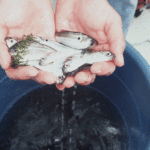
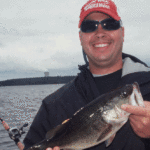
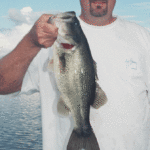


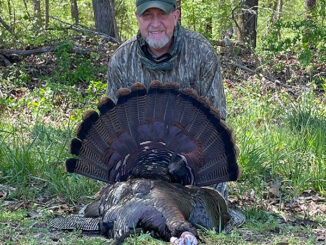
Be the first to comment